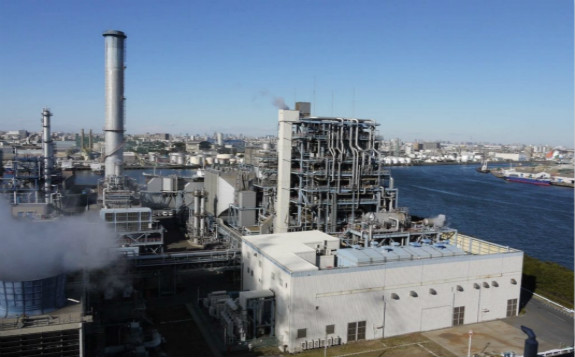A pilot hydrogen project has begun providing fuel for the gas turbines at a facility near Tokyo, Japan. Chiyoda Corp. on June 25 said the project using imported hydrogen is now powering generators at the Toa Oil Co. refinery in Kawasaki.
Chiyoda, along with Mitsubishi Corp., Mitsui & Co., and Nippon Yusen, has been working on the project since 2015. The companies on Thursday said the project is the first to use imported hydrogen for power generation in Japan, and also said marks the world’s first successful international hydrogen supply chain.
The companies’ research division, the Advanced Hydrogen Energy Chain Association for Technology Development, or AHEAD, has a hydrogenation plant in Brunei and a dehydrogenation plant in Japan.
“Our mission is to spread hydrogen,” Takakazu Morimoto, president of AHEAD, told a news conference Thursday in Kawasaki. “We want to use hydrogen extracted from renewable energy in the future and establish a strong supply chain.”
The companies said the project uses the organic chemical hydride method to produce hydrogen by steam reforming processed gas from the liquefied natural gas (LNG) liquefaction process in Brunei. The hydrogen is converted by hydrogenation reaction using toluene into methylcyclohexane (MCH), which is a liquid at ambient temperature and pressure, meaning existing facilities can be used for storage and transport.
The MCH is shipped to Tokyo Bay, where the hydrogen is extracted at the new dehydrogenation plant at the Keihin refinery, operated by Toa Oil, a subsidiary of Idemitsu Kosan. The project supplies the separated hydrogen from the dehydrogenation plant and blends it with byproduct gas to fuel gas turbines at the 80-MW Mizue Power Station inside the Keihin refinery. The toluene used in the process is then returned to Brunei for re-use in the hydrogenation process.

The project is operating with a subsidy from the state-owned New Energy and Industrial Technology Development Organization (NEDO). The project’s immediate goal is to export at least 210 metric tons of hydrogen annually from Brunei to Japan. The pilot is scheduled to run through November 2020.
Goal: A 1-GW Hydrogen-Fired Plant
Morimoto said AHEAD’s longer-term goal is “to transport 350,000 tonnes of hydrogen a year to power a 1-gigawatt hydrogen-fired power plant in 2030.”
“We are transporting hydrogen in normal temperature and pressure, and basically we can use existing facilities, which handle petroleum and others,” said Morimoto. “Through the execution and operation of the Brunei-Japan supply chain, we aim to prove the technology is ready for practical operations and intend to continuously collect various data and analyze it and make improvements for commercialization.”
The use of hydrogen as a fuel is gaining traction worldwide as a cleaner source of energy compared to fossil fuels. A combined heat and power plant in France is being converted to demonstrate the power-to-hydrogen-to-power cycle. Other hydrogen power projects are being developed, including a Mitsubishi Hitachi Power Systems installation in the Netherlands.
A Washington, D.C.-based company in May said it had a deal with a California city to build the world’s largest green hydrogen production plant. Four U.S. nuclear power providers earlier this month said they are working on projects to demonstrate hydrogen production at nuclear plants. And the offshore wind industry is looking at hydrogen production as a way to spur growth in that sector.
NEDO also is assisting the Hydrogen Energy Supply-chain Technology Research Association (HySTRA) on a pilot project this year and next, to demonstrate brown coal gasification and hydrogen refining at Latrobe Valley in Australia. The groups also are working together on hydrogen liquefaction and storage of liquefied hydrogen at Hastings, New Zealand, as well as marine transportation of liquefied hydrogen from Australia to Japan, and unloading of liquefied hydrogen in Japan.
HySTRA’s members includes Iwatani, Shell Japan, Electric Power Development Co. (known as J-POWER), Marubeni, ENEOS, Kawasaki Heavy Industries, and Kawasaki Kisen Kaisha (known as “K” LINE.).